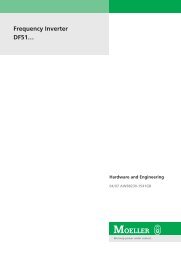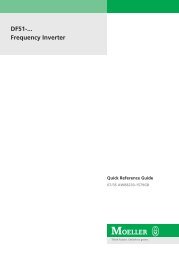Hardware and Engineering DF6-340-... Frequency ... - Moeller.com.tr
Hardware and Engineering DF6-340-... Frequency ... - Moeller.com.tr
Hardware and Engineering DF6-340-... Frequency ... - Moeller.com.tr
You also want an ePaper? Increase the reach of your titles
YUMPU automatically turns print PDFs into web optimized ePapers that Google loves.
Setting Parameters01/02 AWB8230-1413GBSetting the PID parametersValues for the PID parameters must be chosen depending on theapplication <s<strong>tr</strong>ong>and</s<strong>tr</strong>ong> the system’s con<strong>tr</strong>ol characteristics. The followingpoints are important to achieve effective PID con<strong>tr</strong>ol:• A stable steady-state behaviour• A fast response• A small system deviation in the steady stateParameters K p , T i <s<strong>tr</strong>ong>and</s<strong>tr</strong>ong> K d must be set within the stable operatingrange. As a general rule, increasing one of the parameters K p , K i(= reduction of T i ) <s<strong>tr</strong>ong>and</s<strong>tr</strong>ong> K d results in a faster system response. Avery large increase however, causes system instability, as thereturned actual value will begin to oscillate, in the worst case,resulting in divergent behaviour (a fig. 118 to fig. 121):aFigure 120: Good con<strong>tr</strong>ol characteristicsw: Setpointa Output signalwtwwaattFigure 118: Divergent behaviourw: Setpointa Output signalFigure 121: Slow con<strong>tr</strong>ol, large static system deviationw: Setpointa Output signalaFigure 119: Oscillation, dampenedw: Setpointa Output signalwtThe following table provides guidelines for setting eachparameter.Table 22:A setpointchangeSetpoint <s<strong>tr</strong>ong>and</s<strong>tr</strong>ong>actual valueSetting the con<strong>tr</strong>ol timescauses a slow response:causes a fast but unstablereactiondiffer greatlyapproach each other afteroscillation:Increase proportional<s<strong>tr</strong>ong>com</s<strong>tr</strong>ong>ponent (K p )Set a lower P<s<strong>tr</strong>ong>com</s<strong>tr</strong>ong>ponentReduce integral<s<strong>tr</strong>ong>com</s<strong>tr</strong>ong>ponent (T i )Set a higher I<s<strong>tr</strong>ong>com</s<strong>tr</strong>ong>ponentAfterthe response is still slow Increase D <s<strong>tr</strong>ong>com</s<strong>tr</strong>ong>ponentincreasing K p (K d )the response is stillunstableSet a lower D<s<strong>tr</strong>ong>com</s<strong>tr</strong>ong>ponent118







